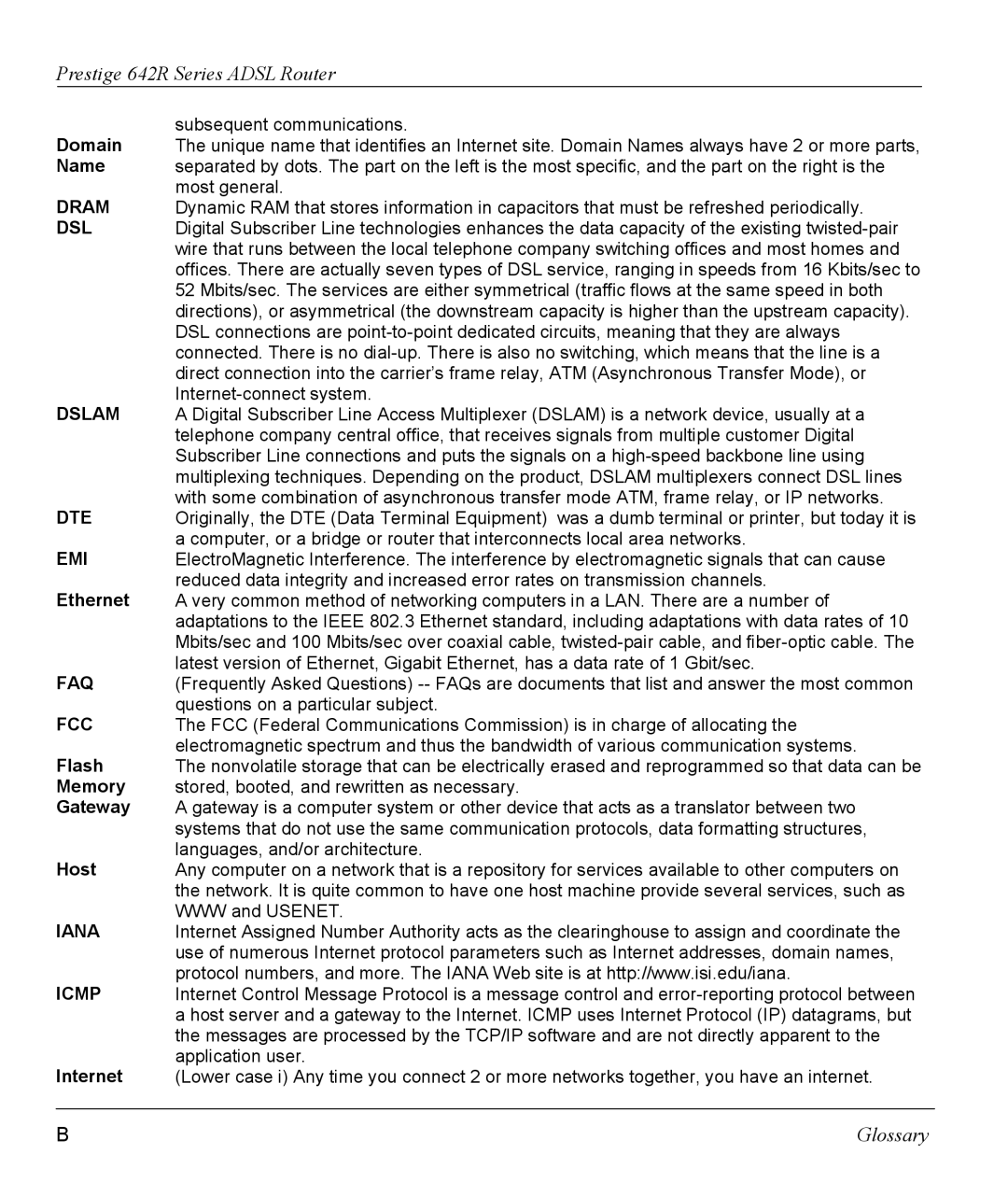
Prestige 642R Series ADSL Router
Domain | subsequent communications. |
The unique name that identifies an Internet site. Domain Names always have 2 or more parts, | |
Name | separated by dots. The part on the left is the most specific, and the part on the right is the |
DRAM | most general. |
Dynamic RAM that stores information in capacitors that must be refreshed periodically. | |
DSL | Digital Subscriber Line technologies enhances the data capacity of the existing |
| wire that runs between the local telephone company switching offices and most homes and |
| offices. There are actually seven types of DSL service, ranging in speeds from 16 Kbits/sec to |
| 52 Mbits/sec. The services are either symmetrical (traffic flows at the same speed in both |
| directions), or asymmetrical (the downstream capacity is higher than the upstream capacity). |
| DSL connections are |
| connected. There is no |
| direct connection into the carrier’s frame relay, ATM (Asynchronous Transfer Mode), or |
DSLAM | |
A Digital Subscriber Line Access Multiplexer (DSLAM) is a network device, usually at a | |
| telephone company central office, that receives signals from multiple customer Digital |
| Subscriber Line connections and puts the signals on a |
| multiplexing techniques. Depending on the product, DSLAM multiplexers connect DSL lines |
DTE | with some combination of asynchronous transfer mode ATM, frame relay, or IP networks. |
Originally, the DTE (Data Terminal Equipment) was a dumb terminal or printer, but today it is | |
EMI | a computer, or a bridge or router that interconnects local area networks. |
ElectroMagnetic Interference. The interference by electromagnetic signals that can cause | |
Ethernet | reduced data integrity and increased error rates on transmission channels. |
A very common method of networking computers in a LAN. There are a number of | |
| adaptations to the IEEE 802.3 Ethernet standard, including adaptations with data rates of 10 |
| Mbits/sec and 100 Mbits/sec over coaxial cable, |
FAQ | latest version of Ethernet, Gigabit Ethernet, has a data rate of 1 Gbit/sec. |
(Frequently Asked Questions) | |
FCC | questions on a particular subject. |
The FCC (Federal Communications Commission) is in charge of allocating the | |
Flash | electromagnetic spectrum and thus the bandwidth of various communication systems. |
The nonvolatile storage that can be electrically erased and reprogrammed so that data can be | |
Memory | stored, booted, and rewritten as necessary. |
Gateway | A gateway is a computer system or other device that acts as a translator between two |
| systems that do not use the same communication protocols, data formatting structures, |
Host | languages, and/or architecture. |
Any computer on a network that is a repository for services available to other computers on | |
| the network. It is quite common to have one host machine provide several services, such as |
IANA | WWW and USENET. |
Internet Assigned Number Authority acts as the clearinghouse to assign and coordinate the | |
| use of numerous Internet protocol parameters such as Internet addresses, domain names, |
ICMP | protocol numbers, and more. The IANA Web site is at http://www.isi.edu/iana. |
Internet Control Message Protocol is a message control and | |
| a host server and a gateway to the Internet. ICMP uses Internet Protocol (IP) datagrams, but |
| the messages are processed by the TCP/IP software and are not directly apparent to the |
Internet | application user. |
(Lower case i) Any time you connect 2 or more networks together, you have an internet. |
B | Glossary |
